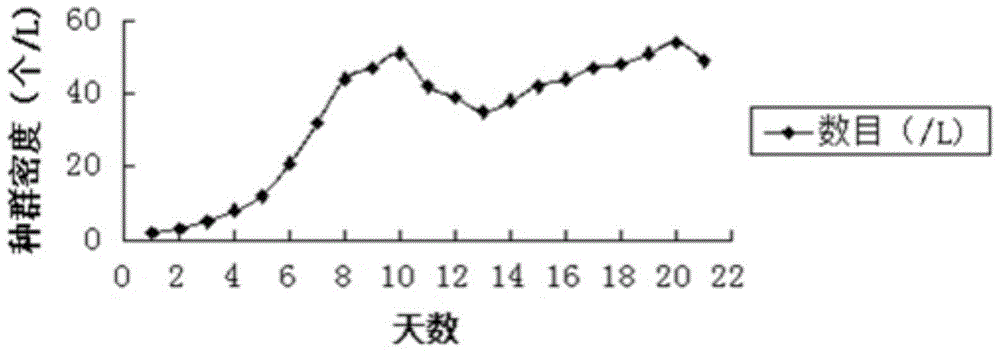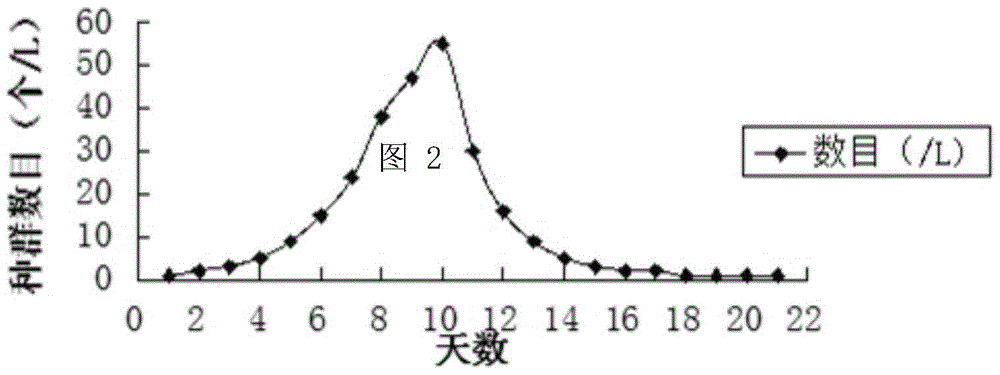A method for screening, purifying and large-scale cultivation of Daphnia warmi
A technology of warm sword Daphnia and cultivation method, applied in the direction of climate change adaptation, fish farming, application, etc., can solve the problems of staying in natural reproduction, etc., and achieve the effects of moderate size, fast reproduction, and improved survival rate
- Summary
- Abstract
- Description
- Claims
- Application Information
AI Technical Summary
Problems solved by technology
Method used
Image
Examples
specific Embodiment
[0024] A method for screening, purifying and large-scale cultivation of Daphnia warmis, which captures copepod populations from estuaries or breeding ponds at the junction of salty and fresh water; under set conditions, conducts directional screening to obtain Daphnia warmis; optimizes breeding of Daphnia warmi Under the conditions of large-scale continuous cultivation, the specific steps are as follows:
[0025] (1) Germplasm acquisition: In estuaries or breeding ponds at the junction of salty and fresh water, when the water temperature is 18-22°C (generally at the transition from spring to summer or late autumn), select areas with a water body specific gravity between 1.005-1.012, and use 120 mesh A trawl or a dredging net made of sieve silk is used to harvest the copepod population at the surface of the 30-50cm water body as a source of germplasm for screening;
[0026] (2) Directional screening: After cultivating the harvested copepod population at a temperature of 20±2°C,...
Embodiment 1
[0030] A method for screening, purifying and large-scale cultivation of Daphnia warmipla, the specific steps are as follows:
[0031] (1) Germplasm acquisition: In the estuary or aquaculture pond at the junction of salty and fresh water, when the water temperature is 20°C, select an area with a water body specific gravity of 1.008, use a 120 mesh sieve silk net to trawl or dredge, and place it on the surface of a 40cm water body Copepod populations were harvested as germplasm sources for screening;
[0032] (2) Directional screening: After cultivating the harvested copepod population for 6 days under the conditions of temperature 20°C, salinity 10, and light intensity 90 Lux, raise the water temperature to 24°C, lower the salinity to 8, and cultivate for 4 days. Then return to the initial cultivation conditions of temperature 20°C, salinity 10, and light intensity 90 Lux and cultivate for 6 days to complete a cycle of directional screening. After completing at least one cycle ...
Embodiment 2
[0036] With above-mentioned embodiment 1, its difference is:
[0037]In step (1), at the estuary at the junction of salty and fresh water, when the water temperature is 18°C, select an area with a water body specific gravity of 1.005, use a 120-mesh tulle net to trawl or dredge, and harvest copepods at the surface of the 30cm water body population as a source of germplasm for screening;
[0038] In step (2), cultivate the harvested copepod population at a temperature of 18°C, a salinity of 7, and a light intensity of 30 Lux for 7 days, raise the water temperature to 22°C, and lower the salinity to 7, cultivate for 5 days, and then restore Cultivate for 7 days under the initial cultivation conditions temperature of 18°C, salinity of 7, and light intensity of 30 Lux, and complete a cycle of directional screening. After culturing for 1-2 weeks under the conditions of 18°C, salinity 7, and light intensity 30Lux, a certain density of Daphnia warmipla populations can be obtained; ...
PUM
 Login to View More
Login to View More Abstract
Description
Claims
Application Information
 Login to View More
Login to View More - R&D
- Intellectual Property
- Life Sciences
- Materials
- Tech Scout
- Unparalleled Data Quality
- Higher Quality Content
- 60% Fewer Hallucinations
Browse by: Latest US Patents, China's latest patents, Technical Efficacy Thesaurus, Application Domain, Technology Topic, Popular Technical Reports.
© 2025 PatSnap. All rights reserved.Legal|Privacy policy|Modern Slavery Act Transparency Statement|Sitemap|About US| Contact US: help@patsnap.com



